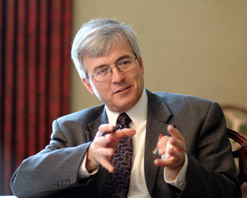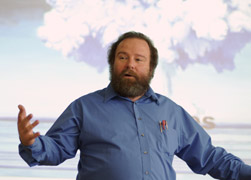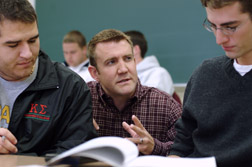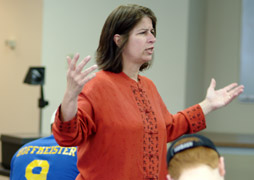 | |
| Dean Mauri Ditzler |
So why is the Dean smiling?
He’s smiling because he knows the good teaching and advising that have long been hallmarks at Wabash will continue well into the future. While five legends retire, Ditzler welcomes a new flock of young, talented, and eager faculty for the 2004-05 academic year. Bridging the gap between the legends and new hires, are seasoned veterans who will teach the new teachers the "Wabash way."
The "Wabash way" involves intense, personal, challenging, supportive teaching, mentoring, and counseling. And it works, according to all sorts of national surveys.
The National Survey of Student Engagement, based at Indiana University, cites Wabash as setting national benchmarks for student-faculty interactions. In its rankings of the "Best 357 Colleges," The Princeton Review ranks Wabash fifth for "Professors Bring Material to Life;" 10th for "Professors Make Themselves Available;" and 11th for "Best Overall Academic Experience for Undergraduates." The CIRP survey, based at UCLA, reports that more than 97 percent of Wabash seniors would choose Wabash all over again if possible. Such student satisfaction is based in large part on the faculty of the College.
But how are good teaching, mentoring, and advising passed along from one generation of teachers to the next?
Ask second-year chemistry professor Lon Porter, who team-taught his first year at Wabash with two of the College’s most respected teachers.
"David Phillips and Rich Dallinger are two very sharp guys, and it was a pretty rapid evolution," says Porter, who also pioneered Wabash’s first nanotechnology course. "At the research university where I did my graduate work, teaching was not a priority, so I was looking forward to coming to a place where teaching comes first. What I saw really stunned me the first couple of times I saw it; there was a level of teaching that was amazing, and that’s what I’m working towards."
"The mentoring at Wabash is not always formal, but it is profound," says fourth year psychology professor Bobby Horton. "More experienced faculty take a genuine interest in their younger colleagues and seem to truly want us to succeed."
 | |
| History professor Rick Warner |
Bringing Material to Life
Newly tenured biochemist Ann Taylor says the key to good teaching and learning at Wabash is making real world applications available to students. She often has students write newspaper articles about infectious diseases. Not only does it force them to get a full handle on the disease, but to present it thoughtfully so that the "average reader" can understand it. She also uses case studies.
"Case studies integrate real world situations with the content we’re studying. "The Case of the Tainted Tacos" examines the use of genetically modified foods. We read a story to set up the scenario, then students learn about how genetically modified foods are made and some of the concerns related to genetically modified foods from literature papers. Through the case study approach, students learn about a topic in greater depth and apply what they’re learning to the real world."
Most Wabash faculty agree that engaging students today means breaking the mould, being creative, and allowing the syllabus to guide a course, not dictate it. And lectures? Forget about them. Wabash professors get discussions started, then allow students to take the conversation in ways that best illuminate the material for them.
 | |
| Psychology professor Bobby Horton |
At Wabash, experience (and experienced discussion leaders) lead to learning. "I hope that I challenge my students to see familiar things from a new angle of vision," says Associate Professor of Economics Kay Widdoes. "Some of the most critical insights that students achieve come out of the application of somewhat dry analytical tools to real-world decisions, whether at the personal level or the policy level."
Dean Ditzler says one of the first things he looks for when interviewing prospective faculty is how they react to students when they are on campus. Do they talk down to them or do they treat students as equals in the learning process? He also points out that there is a certain kind of teacher who "fits" Wabash; one who is willing to put student learning above all other scholarly goals.
Associate Professor of Theater Michael Abbott goes further. Over the years he’s learned to be flexible to student learning styles as well. "I’ve become a less structured, more spontaneous teacher. My grip on each course is a bit less tight than it used to be, and I think that makes me more responsive to what happens day to day in my classes."
 | |
| Theater professor Mike Abbott |
Learning at the Source
During its strategic planning cycle five years ago, Wabash faculty and administrators developed short-term "Immersion Learning" courses to augment the curriculum. It became clear that some courses required travel—distant travel—for students to absorb the maximum content from the material. Since then, more than 40 classes and well over 400 students have traveled the globe to learn at the source, all at no additional expense to the students.
Dan Rogers, who teaches Spanish and just received tenure, knows that immersing students in the subject matter is critical to his work with them.
 | |
| Spanish professor Dan Rogers |
Rogers co-taught with Warner a Latin American history course taught entirely in Spanish. Over Spring Break, the class of 16 students traveled throughout Mexico collecting data and learning about the culture, politics, and religions of indigenous people of the region.
Retired classicist John Fischer has taken classes to Rome (Roman Art and Archeology) and Greece (Greek Art and Archeology). And on his last trip, he took two younger faculty colleagues to teach them the ropes of international travel with Wabash students. One of them was first-year art historian Elizabeth Lee.
 | |
| Art professor Elizabeth Lee |
"Forget what comes to mind when you think of a group of students from an all-male college on spring break in Greece—these students really treated the trip with the respect and effort it deserved and John had a lot to do with that. What was amazing is not just that he could command such a level of diligence, but that the students also so thoroughly enjoyed his company."
Widdoes has created a couple of "immersion" experiences with students. The first, a joint political science and economics study of the European Union, was among the first international trips taken by Wabash students outside of the modern languages department.
"The trip provides a central focus to the course and divides it neatly between theory and research. Visiting the European Union’s headquarters in Brussels helps students to make sense of what is a very complex, dynamic institution that is only very superficially similar to the structure of the U.S. Talking to M.E.P.’s, U.S. government representatives, and ordinary Europeans helps students to understand the complexity of the EU and the enormous challenges it faces in unifying Europeans, not only economically and politically, but psychologically."
Making the learning more real are the every day issues that come up. Widdoes’ students were attending a session of the European Parliament in Strasbourg in 2003 when they became embroiled in a labor riot that involved hundreds of striking dockworkers and police in riot gear. Assistant Professor of Religion Bob Royalty and his colleague John Aden of the history department took a class to Turkey—and did so literally on the eve of the US Invasion of Iraq!
Horton adds the other benefits of an immersion trip: "I enjoyed getting to know the students in a different context and really felt like they were engaged with the course material, coming at them, as it was, in real-life situations."
Working Them Hard
One of the aspects of Wabash that newer professors first learn is that Wabash men like a challenge. And sometimes it surprises the profs.
"I’ve discovered that students will complain more if you appear ‘easy’ than if you push them hard," says Warner of his history students. "Some of them are outright brilliant when they get here, but these are a minority. What Wallies share is an intense diligence. ‘This is going to be a hard book’ will not be met with groans, as in other schools. The response will be, ‘bring it on!’"
Horton sees it much the same way. "I tend to describe the typical Wabash student as intelligent, but not the best in his high school class. Mature and driven to succeed academically. Invested in his college and expecting to be pushed by a faculty with whom he wants to have important and deep relationships, in and out of the classroom."
The "in and out of the classroom" teaching and learning experience at Wabash is as essential to the culture as the all-male environment. Wabash’s most successful teachers, young and old, understand that students learn 24/7, and like it that way.
 | |
| Economics professor Kay Widdoes |
The support Wabash faculty are given—from their senior mentors, the Deans’ Office, and generous alumni contributions—allow them to forge life-long and life-changing relationships with their students.
"The ‘typical’ Wabash student, while a bit rough around the edges at first, is very bright, but not particularly intellectual. They just haven’t had a chance yet to learn what a world of the mind can give them. Traveling with colleagues and students in places as remote as the jungles of Chiapas, Mexico or the Amazon rain basin in eastern Ecuador" has a meaningful impact on professors, too, says Rogers. "When I stand with students in a Baroque cathedral, introduce them to living writers, or watch with them freshwater dolphins playing in the wake of our canoe on some tributary of the Amazon, I know I’m showing them worlds they haven’t even dreamed of."
It’s no wonder Dean Mauri Ditzler was smiling as he leaned up against a tall column on that warm May afternoon last fall. In front of him were five faculty veterans who taught thousands of Wabash men. But also there were four dozen teachers he’s hired over the last five years, men and women who learned the Wabash teaching culture from the masters, but are putting their own unique mark on the College.